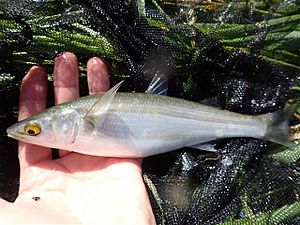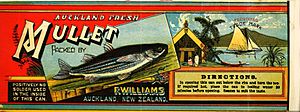Yellow-eye mullet facts for kids
Quick facts for kids Yellow-eye mullet |
|
|---|---|
 |
|
| Conservation status | |
| Scientific classification | |
| Synonyms | |
|
Aldrichetta forsteri nonpilcharda Whitley, 1951 |
Contents
Description
Yellow-eye mullet are small, near-shore fish that usually reach 30–40 cm. Yellow-eyed Mullet fish is gray-green at the top, silver at the bottom, yellow at the bottom, bright yellow eyes. Although yellow-eye fish tastes good, they are most often used as bait fish. Yellow-eye mullet is considered to be the best bait for capturing larger species. Freshly caught mullet fillets, oozing blood and juice, are irresistible to almost any fish in the sea. They also have sharp heads and mouths, and the scales on the body are particularly small and thin and are very easy to fall off. Unlike most fish, it has two ridges, the first with 4 thorns and the second with 1 spine and 9 rays. These fish are olive or blue-brown with silver on both sides and bright yellow or gold eyes. The fins have brown edges. They can live in water depth ranging from 0–50 m, but usually, stay in 0–10 m depth. They are most comfortable in temperature ranging from 14 to 24 degree Celsius, with the upper tolerate temperature of 28 degree Celsius and the lower limit unknown.
Distribution
Natural global range
Southwest Pacific, Also from Western Australia, Southern Australia, and Tasmania.
New Zealand range
All over New Zealand and the Chatham Islands.
Life cycle/phenology
The maximum age of yellow-eyed Mullet is estimated to be 7 years old. They lay their eggs between December and March, but some believe that spawning may also occur in winter. They usually lay their eggs in summer and autumn coastal waters or in the estuary. Each fish can release up to 680,000 eggs. They may live for seven years and mature in 2–4 years. Female grow faster and are more than male.
Diet and foraging
They are omnivores that feed on sea floor debris, algae and small invertebrates, feeding on a variety of foods, including algae, crustaceans, diatoms, mollusks, insect larvae, fish, polychaetes, coelenterates and fish eggs. They are often filtered from the sand through the mouth. Ingesting a certain percentage of sand helps to grind food in the muscles of the stomach.
Predators, parasites and diseases
In the natural food chain, they are preyed by larger predators such as dolphins and killer whales. Since they are usually used as bait fish, most large carnivorous marine life can be used as their predator.
Cultural uses
They have two commercial fisheries. One is the marine beach fishery, the goal is to lay eggs for adults, their caviar is very precious. Demand is high in Australia and overseas. It can be sold fresh, or smoked or dried. Beach fences are used for this type of fishery. The second method of commercial fisheries in the estuary fishery. This accounts for the majority of mullet fish catches. Yellow-eye are caught throughout the year, but most of the capture occurs in late summer and autumn. Coastal collection gill nets and tunnel nets are the main gear forms used in the fishery. People usually look for shiny skin, solid meat, and a fresh marine scent when choosing fish. In the fillets, look for pink, grey, solid, shiny, moist meat without any brown markings or oozing water and a pleasant fresh marine scent.
- Tony Ayling & Geoffrey Cox, Collins Guide to the Sea Fishes of New Zealand, (William Collins Publishers Ltd, Auckland, New Zealand 1982) ISBN: 0-00-216987-8
See also
 In Spanish: Aldrichetta forsteri para niños
In Spanish: Aldrichetta forsteri para niños



